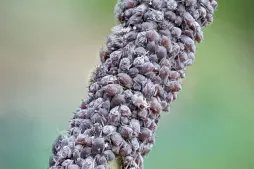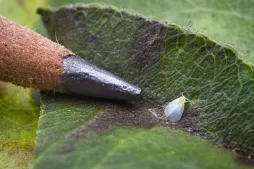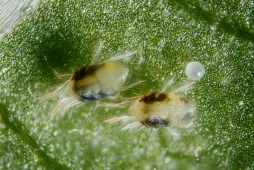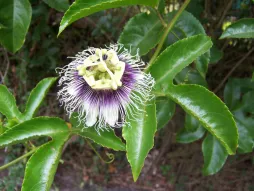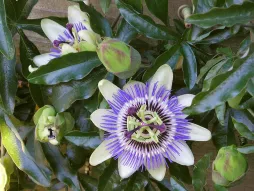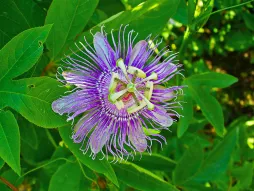Passiflora edulis forme edulis, purple grenadilla
Want to taste your own passion fruit? Plant a Passiflora edulis form edulis! Violet pomegranate will delight you with its juicy berries, and you'll also be treated to spectacular flowering!
How to recognize the violet grenadilla, Passiflora edulis f. Edulis?
Passiflora edulis form edulis is a climbing shrub with a spreading habit. It grows to a height of eight meters and a spread of four meters.
The green, woody stems reach six meters in length. Voluble, they cling to their support with tendrils at the base of the leaves.
The thick leaves are bright, glossy green. Each leaf has three oval or elliptical lobes with serrated margins.
Passiflora edulis flowers in summer. In mild climates, the citrus-scented bloom lasts until early autumn. The flowers measure almost ten centimetres in diameter. They bloom singly in the leaf axils. On the whitish petals and sepals is a crown of white and violet filaments. In the center are five green stamens and three styles ending in stigmas. This inflorescence attracts bees and pollinators.
Passiflora edulis f. Edulis gives rise to the passion fruit. This purple-peeled berry contains an orange pulp and black seeds. Its taste is sweeter than that of maracuja, the fruit of yellow Grenadilla (Passiflora edulis).
Passion fruit is edible, but the rest of the plant is toxic. The leaves and stems cause stomach upsets when ingested. Keep your plant away from young children and pets!
Our maintenance tips
Would you like your Violet grenadilla to bear fruit? You may need to grow several specimens. Some self-sterile varieties need to be planted alongside others purple Grenadilla for pollination to take place.
Watering
Your Violet grenadilla likes humidity. The plant appreciates frequent and generous watering. But its roots may rot if you overwater. To get the dosage right, leave the soil to dry out partially between two waterings (by about a centimetre). The substrate should always remain slightly moist.
After each watering, remove any stagnant water from the saucer or planter to avoid drowning the roots.
Repotting
Purple Grenadilla are fast-growing. Choose a pot with holes at least 40 centimetres deep to give the plant room to develop its root system. You can line the bottom with a layer of clay balls or gravel to improve drainage.
Your plant needs a rich, draining substrate. You can mix equal parts topsoil and potting soil and add a handful of compost and sand. If you don't have any, a mixture for Mediterranean plants is also suitable.
Pour substrate into the hole. If you have provided a stake, install it in your pot now. Plant your Violet grenadilla. The collar and root ball should be a few centimetres below the rim of the pot to leave a watering trough. Add potting soil up to the root ball. Tamp and water.
Your plant will cling to its support itself thanks to its tendrils. But you'll need to give it a little help when planting. Arrange the vines in a zigzag pattern along your wall, pergola or fence.
Fertilization
Place compost at the foot of your Violet grenadilla.
You can stimulate the growth of your plant during its growth phase, in spring and summer, with fertilizer.
Fertilize your Violet grenadilla every month. Use a flowering plant fertilizer to stimulate flowering.
Harvest
Depending on the variety, fruit is harvested between early and late summer.
Fruit falls by itself when ripe.
Prune
Remove dry, yellowed leaves.
Using clean, sharp pruning shears, cut back dead branches.
You can also shorten branches to maintain a compact habit.
Plantation
Once the last spring frosts have passed, you can plant.
Soak your Passiflora edulis f. Edulis to rehydrate the root ball.
The plant has extensive roots. Dig a hole of at least 40 centimetres in all directions to accommodate it. If your soil is heavy and tends to retain water, place two to three centimetres of clay balls or gravel at the bottom to improve drainage.
Prepare a mixture containing equal parts garden soil and potting soil. Add a handful of compost. Pour on a layer of substrate and plant your plant. The rootball should reach ground level.
Fill in the hole, compact and water. You can mulch with a mineral or organic material to keep the plant cool.
Purple Grenadilla plants have tendrils at the base of their leaves, enabling them to hang on. Planted next to a low wall, trellis or pergola, your plant will climb naturally. But you can encourage it by guiding its vines along the support. It's best to run them in a zigzag or horizontal pattern to stimulate growth.
Cutting
Cutting is carried out during the strong growth phase, generally in spring and early summer.
Choose a stem with a soft tip and no flowers. Using a clean, sharp pair of pruning shears, remove a section of about fifteen centimetres with at least three nodes.
Remove the leaves at the base of the plant, keeping only the pair at the top. You can tie up the leaves or halve their size to limit evapotranspiration.
Pour a mixture of potting soil and sand into a pot whose hole has been plugged with a pebble. Push half the stem of your cutting into the center without watering.
Place the pot in a mini greenhouse; if you don't have one, you can cover the plant with a translucent bag or a cut bottle. Place your graft in a bright spot, without direct sunlight.
Every day, aerate for a few minutes to drain off condensation and mist.
Every day, aerate for a few minutes to drain off condensation and mist.
Diseases / Threats
Information
| Family | Passifloraceae - Passifloraceae |
| Type | Passionflower - Passiflora |
| Species | Passiflora edulis - Passiflora edulis |
| Lifecycle | Perennial |
| Foliage | Semi-evergreen |
| Exposures | |
| Substrats | |
| Planting methods |
Open ground In pots In tubs |
| Categories | |
| Tags |
Edible fruit Beginner Flowery Toxic |
| Origin |
South America |
| Hardiness (USDA) | 10b |
| Leaf color |
|
| Flower colors |
|
| Fruit color |
|
Discover plants from the same family













